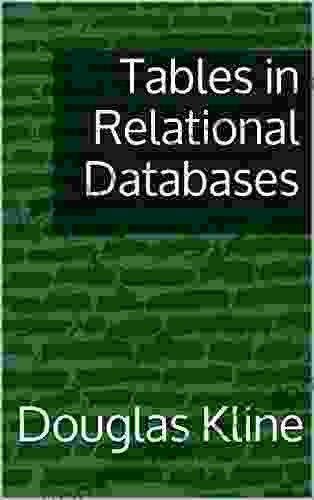Tables in Relational Databases: A Comprehensive Guide

Relational databases are a type of database that organizes data into tables, where each table represents a specific entity or concept. Each table consists of rows, which represent individual records, and columns, which represent different attributes or properties of the records. Relational databases are used in a wide variety of applications, including business intelligence, data analysis, and transaction processing.
Tables are the fundamental building blocks of relational databases. They provide a structured way to store, organize, and retrieve data. Each table has a unique name and is associated with a particular schema, which defines the data types and constraints for each column.
Tables are defined by their columns and rows. Columns represent the different attributes or properties of the records in the table. For example, a customer table might have columns for customer ID, name, address, and phone number. Rows represent individual records, each of which contains a set of values for the columns in the table. For instance, one row in the customer table might represent John Smith, who lives at 123 Main Street and has a phone number of 123-456-7890.
4 out of 5
| Language | : | English |
| File size | : | 968 KB |
| Text-to-Speech | : | Enabled |
| Screen Reader | : | Supported |
| Enhanced typesetting | : | Enabled |
| Print length | : | 12 pages |
| Lending | : | Enabled |
Primary keys and foreign keys are two important concepts in relational databases. A primary key is a unique identifier for each record in a table. It ensures that each record can be uniquely identified and retrieved. A foreign key is a column that references a primary key in another table. This allows tables to be linked together, forming relationships between the data they contain.
Tables in relational databases can be related to each other through various types of relationships. The most common types of relationships are:
- One-to-one: This type of relationship exists when a record in one table is associated with at most one record in another table.
- One-to-many: This type of relationship exists when a record in one table can be associated with multiple records in another table.
- Many-to-many: This type of relationship exists when multiple records in one table can be associated with multiple records in another table.
These relationships are essential for creating complex data models that accurately reflect the real-world entities and their interactions.
Relational databases provide a set of operations that allow users to create, modify, and query tables. These operations include:
- Creating tables: The CREATE TABLE statement is used to create a new table and define its structure.
- Adding data to tables: The INSERT INTO statement is used to add new records to a table.
- Updating data in tables: The UPDATE statement is used to modify existing records in a table.
- Deleting data from tables: The DELETE FROM statement is used to remove records from a table.
- Querying data from tables: The SELECT statement is used to retrieve data from one or more tables based on specified criteria.
The design of database tables is crucial for ensuring efficient data storage and retrieval. The following guidelines can help optimize table design:
- Normalize data: Data should be stored in a manner that minimizes redundancy and maintains data integrity.
- Choose appropriate data types: Data types should be selected to match the nature of the data being stored.
- Establish relationships between tables: Tables should be linked through appropriate relationships to avoid data duplication and improve data consistency.
- Use indexes: Indexes can be created on columns that are frequently used in queries to speed up data retrieval.
- Consider data integrity constraints: Constraints can be applied to tables to ensure the accuracy and validity of the data.
Tables are the core component of relational databases. They provide a structured and efficient way to store, organize, and retrieve data. Understanding the structure of tables, relationships between tables, and table operations is essential for designing and managing effective relational databases. By following best practices for table design and optimization, organizations can ensure the integrity, performance, and usability of their databases.
4 out of 5
| Language | : | English |
| File size | : | 968 KB |
| Text-to-Speech | : | Enabled |
| Screen Reader | : | Supported |
| Enhanced typesetting | : | Enabled |
| Print length | : | 12 pages |
| Lending | : | Enabled |
Do you want to contribute by writing guest posts on this blog?
Please contact us and send us a resume of previous articles that you have written.
 Top Book
Top Book Novel
Novel Fiction
Fiction Nonfiction
Nonfiction Literature
Literature Paperback
Paperback Hardcover
Hardcover E-book
E-book Audiobook
Audiobook Bestseller
Bestseller Classic
Classic Mystery
Mystery Thriller
Thriller Romance
Romance Fantasy
Fantasy Science Fiction
Science Fiction Biography
Biography Memoir
Memoir Autobiography
Autobiography Poetry
Poetry Drama
Drama Historical Fiction
Historical Fiction Self-help
Self-help Young Adult
Young Adult Childrens Books
Childrens Books Graphic Novel
Graphic Novel Anthology
Anthology Series
Series Encyclopedia
Encyclopedia Reference
Reference Guidebook
Guidebook Textbook
Textbook Workbook
Workbook Journal
Journal Diary
Diary Manuscript
Manuscript Folio
Folio Pulp Fiction
Pulp Fiction Short Stories
Short Stories Fairy Tales
Fairy Tales Fables
Fables Mythology
Mythology Philosophy
Philosophy Religion
Religion Spirituality
Spirituality Essays
Essays Critique
Critique Commentary
Commentary Glossary
Glossary Bibliography
Bibliography Index
Index Table of Contents
Table of Contents Preface
Preface Introduction
Introduction Foreword
Foreword Afterword
Afterword Appendices
Appendices Annotations
Annotations Footnotes
Footnotes Epilogue
Epilogue Prologue
Prologue Sara Bourgeois
Sara Bourgeois Tabitha Gibson
Tabitha Gibson Wendy Tones
Wendy Tones Hugh Morrison
Hugh Morrison Meghan March
Meghan March Robert Fabbri
Robert Fabbri Kathleen Sheeder Bonanno
Kathleen Sheeder Bonanno George Tsakraklides
George Tsakraklides Louis Begley
Louis Begley Michael Pickell
Michael Pickell Allen Ellenzweig
Allen Ellenzweig Dannah Gresh
Dannah Gresh Rosie Weldon
Rosie Weldon Bill O Reilly
Bill O Reilly Steven Scott Nestle
Steven Scott Nestle Matty Layne Glasgow
Matty Layne Glasgow Donald Justice
Donald Justice John Reisinger
John Reisinger Kuei Shien Lee
Kuei Shien Lee Jim Euclid
Jim Euclid
Light bulbAdvertise smarter! Our strategic ad space ensures maximum exposure. Reserve your spot today!

 Pat MitchellCut the Deadly Mistakes All New Screenwriters Make: A Comprehensive Guide to...
Pat MitchellCut the Deadly Mistakes All New Screenwriters Make: A Comprehensive Guide to... Ian PowellFollow ·19.2k
Ian PowellFollow ·19.2k Anton FosterFollow ·13.5k
Anton FosterFollow ·13.5k Aron CoxFollow ·10.7k
Aron CoxFollow ·10.7k Greg CoxFollow ·13.5k
Greg CoxFollow ·13.5k Anthony BurgessFollow ·6.2k
Anthony BurgessFollow ·6.2k Oliver FosterFollow ·15.2k
Oliver FosterFollow ·15.2k Raymond ChandlerFollow ·10.2k
Raymond ChandlerFollow ·10.2k Jace MitchellFollow ·15.9k
Jace MitchellFollow ·15.9k

 Abe Mitchell
Abe MitchellWhy Unleashing the Instinct to Play Will Make Our...
Play is an essential part of childhood. It is...

 Rubén Darío
Rubén DaríoTheory in Health Promotion Research and Practice
Theory is essential...

 Howard Blair
Howard BlairFailing Students or Failing Schools: Uncovering the Root...
In the United States, the issue of failing...

 Ira Cox
Ira CoxPoetry From the Heart Chope: A Symphony of Soul and Verse
Embark on a literary...

 Easton Powell
Easton PowellThe Witch Hunt: Wicked Witches of Shadow Woods
In the cursed woods of...
4 out of 5
| Language | : | English |
| File size | : | 968 KB |
| Text-to-Speech | : | Enabled |
| Screen Reader | : | Supported |
| Enhanced typesetting | : | Enabled |
| Print length | : | 12 pages |
| Lending | : | Enabled |












